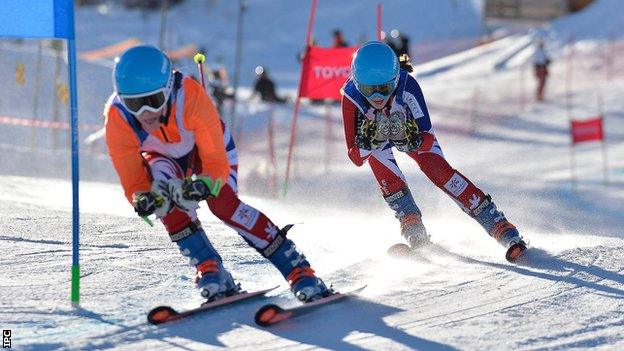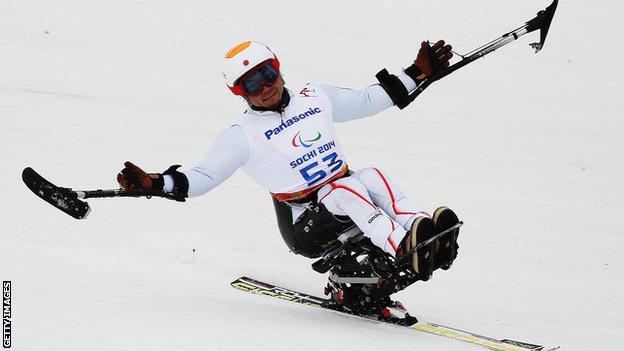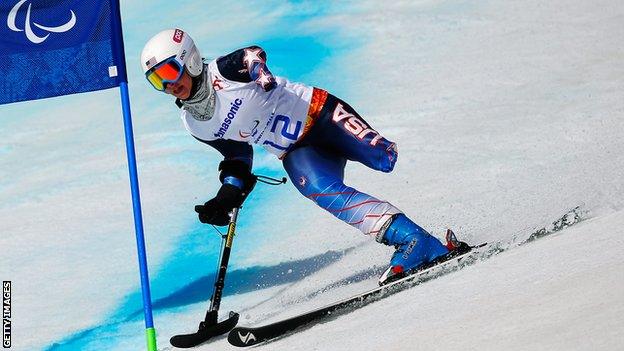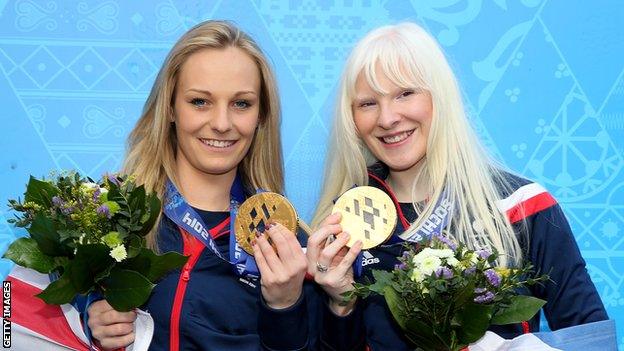Para-alpine skiing at the 2018 Winter Paralympics: All you need to know
- Published

Britain's Menna Fitzpatrick is guided down the course by Jen Kehoe
Paralympic Games on the BBC |
|---|
Venue: Pyeongchang, South Korea Dates: 9-18 March Time in Pyeongchang: GMT +9 |
Coverage: Follow on Radio 5 live and via the BBC Sport website. Television coverage on Channel 4. |
Alpine skiing has been one of the mainstays of the Winter Paralympic programme since the first Games in Sweden in 1976.
The first Games featured athletes in the standing classes only in slalom and giant slalom events.
Downhill was added to the programme in 1984 in Innsbruck, Austria, and super G was added in 1994 at Lillehammer, Norway.
Sit-skiing was introduced as a demonstration sport in Innsbruck and became a medal event in Nagano, Japan, in 1998.
Basic rules
Competitors have a variety of physical impairments, including spinal injuries, cerebral palsy, amputation and visual, and compete in three categories - seated, standing and visually impaired.
A results calculation system allows athletes with different impairments within the same category (i.e. totally blind and visually impaired) to compete against each other.
Results are factored to take into account each athlete's degree of impairment when calculating a time.
Athletes and spectators see the factored time after each run and the winner is the athlete who records the fastest factored time over the course.
Skiers who are blind or visually impaired use sighted guides and communication tools to help them down the course while those in the standing and seated categories will use equipment which is adapted to their needs.

Japanese sit-skier Akira Kano won two gold medals at the Sochi Winter Paralympics
There are five events on the programme for Pyeongchang:
Downhill
Each athlete completes one run and ski down a long, steep course and must pass through a relatively few number of gates. If an athlete misses a gate they are disqualified.
Slalom
Each athlete completes two runs on the same day on different courses. Times from the two runs are added together to determine the final order based on ascending total time. It is a technical event over a shorter course than other events but with a high number of gates that the athlete must negotiate. If an athlete misses a gate they are disqualified.

American skier Stephanie Jallen was among the medallists in Sochi four years ago
Giant slalom
Each athlete completes two runs on the same day on different courses. Times from the two runs are added together to determine the final order based on ascending total time. It is a technical event with a longer course and fewer gates than the slalom. The number of gates is determined by the vertical drop of the course. If an athlete misses a gate they are disqualified.
Super G
A speed event where each athlete completes one run. The course is generally shorter than downhill but longer than slalom and giant slalom.
Super combined
A combined competition which represents the final result of two disciplines - usually one of either a downhill or super G and a single run of slalom. Each athlete competes two runs on the same day on different courses. Times from the two runs are added together to determine the final order based on ascending total time.

Kelly Gallagher (right) and guide Charlotte Evans created history in Sochi
GB Paralympic history
The first medal ever won by Great Britain was a bronze for John Watkins in the men's alpine Combination at the 1984 Games in Innsbruck.
Kelly Gallagher and guide Charlotte Evans won Britain's first Winter Paralympic gold in Sochi where team-mate Jade Etherington claimed three silvers and a bronze.
Millie Knight, who made her Paralympic debut in Sochi aged 15, and her guide Brett Wild are the current world downhill champions while Menna Fitzpatrick and Jen Kehoe have also won medals on the World Cup circuit this year
Did you know?
Skiers can reach speeds of 100km/h on the slopes.
German sit-skier Anna Schaffelhuber won gold medals in all five of her events in Sochi - becoming only the second person to achieve the feat.
Austrian skier Robin Cuche's uncle Didier won Olympic silver in the Super G event in Nagano in 1998.
American visually impaired skier Mark Bathum will take to the slopes aged 59 and is set to be the oldest competitor in the field.